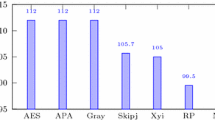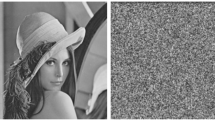Abstract
The encryption process relies on the use of nonlinear mapping subsystems to create confusion in the ciphertext. The design of these nonlinear components is a challenging task and requires complex algebraic expression for their descriptions. In an effort to increase the complexity of nonlinear mappings, several implementations exhibiting interesting properties are proposed in the literature. In particular, affine-power-affine structure is designed for advanced encryption standard, which improves the complexity of its algebraic expression by increasing the number of terms. Based on the characteristics of affine-power-affine structure, we propose a new nonlinear component that uses the symmetric group permutation S8 on the Galois field GF(28) elements and provides the possibility to incorporate 40320 unique instances. A rigorous analysis is presented to evaluate the properties of these new nonlinear components by applying nonlinearity analysis, linear approximation analysis, differential approximation analysis, bit independence criterion and strict avalanche criterion. In order to determine the suitability to various encryption applications, the S-boxes are tested with generalized majority logic criterion.

Similar content being viewed by others
Explore related subjects
Discover the latest articles and news from researchers in related subjects, suggested using machine learning.References
National Institute of Standard and Technology (2001) Advanced Encryption Standard FIPS197 [S] November 26
Ferguson N, Schroeppel R, Whiting D (2001) A simple algebraic representation of Rijndael. In: Selected Areas in Cryptography SAC01, NCS2259, pp 103–111
Murphy S, Robshaw MJ (2002) Essential algebraic structure within the AES. In: Crypto’02, LNCS, vol 2442, pp 1–16
Rosenthal J (2003) A polynomial description of the Rijndael Advanced Encryption Standard. J Algebra Appl 2(2):223–236
Morioka S, Satoh A (2002) An optimized S-box circuit architecture for low power AES design. In: Workshop on Cryptographic Hardware and Embedded Systems (CHES.02), LNCS 2523, pp 172–186
Mentens N, Batina L, Preneel B, Verbauwhede I (2005) A systematic evaluation of compact hardware implementations for the Rijndael S-box. In: Menezes A (ed) CT-RSA, LNCS, vol 3376. Springer-Verlag, New York, pp 323–333
Cui L, Cao Y (2007) A new S-box structure named affine-power-affine. Int J Innov Comput Inform Control 3(3):45–53
Tran MT, Bui DK, Doung AD (2008) Gray S-box for advanced encryption standard. Int Conf Comput Intell Security 1:253–256
Hussain I, Shah T, Mahmood H (2010) A new algorithm to construct secure keys for AES. Int J Contemp Math Sci 5(26):1263–1270
Liu J, Wai B, Cheng X, Wang X (2005) An AES S-box to increase complexity and cryptographic analysis. In: Proceedings of the 19th international conference on advanced information networking and applications (AI-NA.05), vol 1, pp 724–728
Shah T, Hussain I, Gondal MA, Mahmood H (2011) Statistical analysis of S-box in image encryption applications based on majority logic criterion. Int J Phys Sci 6(16):4110–4127
Hussain I, Shah T, Gondal MA, Mahmood H (2012) Generalized majority logic criterion to analyze the statistical strength of S-boxes. Z Naturforsch 67a(5):282–288
Ahmed W, Mahmood H, Siddique U (2011) The efficient implementation of S8 AES algorithm. Lect Notes Eng Comput Sci 2191(1):1215–1219
Author information
Authors and Affiliations
Corresponding author
Rights and permissions
About this article
Cite this article
Hussain, I., Shah, T., Gondal, M.A. et al. S8 affine-power-affine S-boxes and their applications. Neural Comput & Applic 21 (Suppl 1), 377–383 (2012). https://doi.org/10.1007/s00521-012-1036-9
Received:
Accepted:
Published:
Issue Date:
DOI: https://doi.org/10.1007/s00521-012-1036-9




